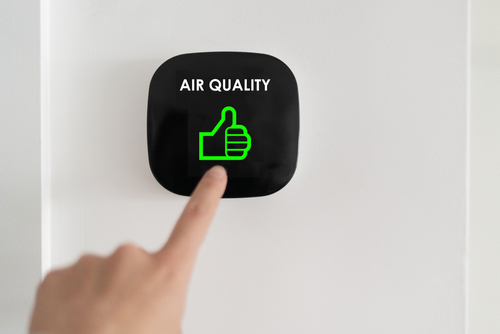Buildings are more complex machines than most people realize. Understanding how to read a Building Management System (BMS) to troubleshoot maintenance issues is in itself complicated and often difficult. Most tenants don’t know how to effectively read their energy or water utility data, nor do many have interest in these items unless they are the leaseholder and are paying them as part of a net metering program.

However, the one piece of building information that is now on everyone’s mind is indoor air quality data. Given that we drink 6 liters of water a day but breathe nearly 14,000 liters of air, it’s no surprise that what we breathe is on people’s minds. And if it isn’t yet, it really should be.
What Recent Healthy Building Studies Suggest
In a recent healthy buildings survey by Honeywell, it was found that amongst American workers, 9 out of 10 believe that the quality of the air they breathe has a direct impact on their health and well-being. Of those surveyed, 8 out of 10 also believed that indoor air is less healthy to breathe than outdoor air.
Yet within the study there wasn’t a clear understanding about what made up “poor indoor air.” Of the 3,000 employees surveyed worldwide, 72% considered ventilation as contributing and 64% understood a little about CO2, with a slightly lower percentage (59%) identifying humidity as a contributing factor. Amongst responders, there was no mention of PM2.5 (i.e., dust) nor of volatile organic compounds (VOCs), which are also contributing factors to human health in indoor spaces.
Various green building ratings and regulatory bodies are of some help to employers and facilities managers, but they differ on what they consider healthy.
The World Health Organization (WHO) has set the indoor limit of PM2.5 (fine particulate matter) at 25 μg/m3, with the Fitwel healthy building standard using the same limit. The BOMA Best building standard however has no upper limit, and in contrast, WELL and RESET set their limit closer to 15 μg/m3.
One study found that with a 10 µg/m3 increase in PM2.5, the likelihood of missing work days due to air quality increased by 4.6%, with a 95% confidence interval. Based on global research by the WHO, there are about 10-15 (12.5) absences per worker per year. Therefore, assuming average PM2.5 levels at 10 ug/m3, there would be 12.5 absences per year.
Looking at VOCs (also not on people’s minds for the study), the WHO doesn’t set indoor limits for VOCs, and surprisingly, neither does the Occupational Safety and Health Administration (OSHA). The green building standards however set limits with LEED, Fitwel and WELL referencing 500μg/m3. In this instance, BOMA Best does set a limit of 1000 μg/m3.
The Relationship Between TVOCs and Cognitive Functioning
A relationship has been found between total volatile organic compounds (TVOCs) and cognitive functioning, specifically related to memory (e.g., it’s hard to switch from task to task or quickly remember a fact, etc.). At 500-μg/m3 of TVOCs it is associated with a 13% decrease in cognitive scores. If the relationship is as linear as the one with PM2.5, then that means at 1,000 μg/m3, there is nearly a 30% decrease in cognitive function with high TVOCS.
When it comes to CO2 (something 64% of the respondents were concerned about), we know that the relationship between high levels and cognitive function is just as marked as with TVOCs. Carbon dioxide (which we breathe out) is related to fatigue, dizziness, and nausea.
A study has found that “on average, a 400-ppm increase in CO2 is associated with a 21% decrease in a typical participant’s cognitive scores across all domains,” calculating results between about 500-1,500 ppm.
In Canada, the federal government sets a limit of 800 ppm (with only RESET matching this limit) for their own spaces with federal employees. Yet most of the federal workplace standards for anyone else in Canada are set at 1,000 ppm or greater. If you took the entire nation of Canada and added up all the lost hours of productivity (and we are a very small country), there would be a lot to gain from setting the same limit for all Canadians that we set for federal employees and making sure that workplaces stay within it.
Now that we understand what we would be reading when we look at real-time indoor air quality data, let’s talk about the communication gap. In the same Honeywell study, respondents in the United States are informed less frequently than the global average about their building’s current IAQ (this would be the same or worse in Canada). Just 8% receive information continuously (versus 15% globally), while 74% receive it sometimes, rarely, or never.
Given the massive interest, but also the gap in understanding of what they’d be reading, there is fear on the part of facilities managers and employers to share or even gather the data. Being able to see it in real-time, however, allows one to not just better address what tenants and employees want to know; it also allows for better maintenance of a building.
Real-Time Monitoring of IAQ—a Case Study
One of Airsset’s IAQ consultant partners works with Vancity Credit Union, a client which sets their CO2 limit to 800 ppm like the Canadian federal government does. In the winter, the outdoor air damper was closed (likely due to someone being uncomfortable with the temperature in the space). What that resulted in was CO2 levels closer to 1,300 ppm.
But with real-time monitoring, the team was able to quickly respond to this change and resolve both the comfort and CO2 situation without any additional costs on the project. You can learn all about it from this case study.
If you had an electrical utility meter it would show you (before the bill comes from the utility) what you need to adjust to avoid paying a huge bill at the end of the month. It’s time to start thinking of real-time IAQ monitoring as the meter that allows you to see the bill you’d be paying for lost tenants, lost confidence, and lost productivity.

Michael Driedger is the founder and CEO of Airsset Technologies, a platform of software and IoT devices that allows for the measurement, analysis, and solving of air quality for indoor spaces with the goal to create healthy and productive spaces for all through digital transformation. Prior to launching Airsset, Michael co-founded and was CEO of a software SaaS company in the hospitality space and has had a long career in the green/healthy building industry.
